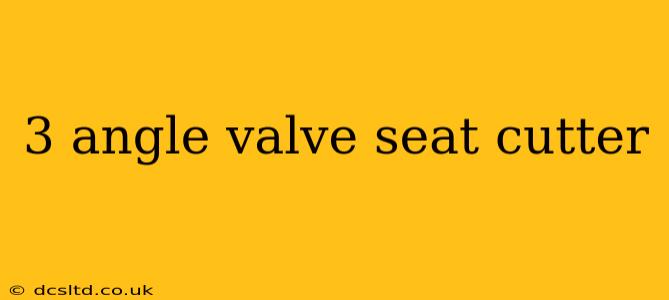Valve seat cutters are essential tools for plumbers, mechanics, and anyone working on internal combustion engines or hydraulic systems. A 3-angle valve seat cutter, in particular, offers precision and versatility, making it a valuable asset for various repair and maintenance tasks. This guide provides a comprehensive overview of 3-angle valve seat cutters, addressing common questions and offering insights into their proper use and maintenance.
What is a 3-Angle Valve Seat Cutter Used For?
A 3-angle valve seat cutter is used to precisely re-seat valves, creating a tight seal to prevent leaks. The "three angles" refer to the cutting angles incorporated into the tool's design. These angles are crucial for creating a properly shaped valve seat that ensures a leak-free connection. They are primarily used on internal combustion engine valves, but find applications in various other systems requiring precision valve reseating. The tool allows for the efficient and accurate cutting of the valve seat to the correct angle and width, preventing costly valve replacements.
What are the Different Types of 3-Angle Valve Seat Cutters?
Several types of 3-angle valve seat cutters exist, varying primarily in their size, material, and drive mechanism. Some are hand-operated, offering greater control in tight spaces, while others utilize pneumatic or electric power for faster and more efficient cutting, especially on larger valve seats. The materials used in their construction generally include high-speed steel for durability and longevity. Choosing the right type depends on the specific application and the size of the valve seat being worked on.
How Do You Use a 3-Angle Valve Seat Cutter?
Using a 3-angle valve seat cutter correctly is vital for achieving a proper valve seat. The process generally involves carefully inserting the cutter into the valve seat, ensuring proper alignment, and then slowly rotating the cutter to create the new seat. The exact procedure will vary slightly depending on the specific cutter model and the type of valve. Always consult the manufacturer’s instructions for the best results and to avoid damage to the tool or the valve. Safety precautions, such as using appropriate eye protection, are essential during operation.
What are the Benefits of Using a 3-Angle Valve Seat Cutter?
The main benefits of using a 3-angle valve seat cutter include:
- Precision: The three-angle design enables precise cutting of the valve seat, ensuring a perfect fit for the valve.
- Efficiency: Compared to other methods, it offers a faster and more efficient way to re-seat valves.
- Cost-Effectiveness: Repairing valve seats is often significantly cheaper than replacing the entire valve.
- Versatility: Many cutters can be used on a range of valve sizes.
How Do I Maintain a 3-Angle Valve Seat Cutter?
Proper maintenance is crucial for the longevity and effectiveness of a 3-angle valve seat cutter. This includes regular cleaning to remove debris and lubricating the moving parts. Storing the cutter in a dry, protected environment is also important to prevent rust and corrosion. Sharp cutters ensure clean cuts and extend the life of the valve seat. Sharpening or replacing cutting bits may be necessary depending on usage.
Where Can I Buy a 3-Angle Valve Seat Cutter?
3-angle valve seat cutters are typically available from automotive parts suppliers, tool distributors, and online retailers. When purchasing, consider the cutter's specifications, materials, and reviews from other users to ensure you are buying a high-quality tool suited to your needs.
What Safety Precautions Should I Take When Using a 3-Angle Valve Seat Cutter?
Safety is paramount when using any power tool. Always wear appropriate safety glasses or a face shield to protect your eyes from flying debris. Ensure the work area is well-ventilated to avoid inhaling any metal dust produced during cutting. Use caution when handling sharp tools. Consult the manufacturer’s instructions for specific safety recommendations for your model. Never force the cutter, as this can damage the tool or the valve seat.
This comprehensive guide should provide a solid understanding of 3-angle valve seat cutters. Remember that proper use, maintenance, and safety practices are crucial for successful valve repair.
